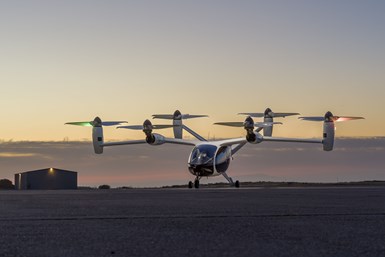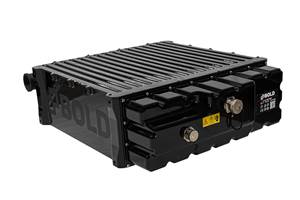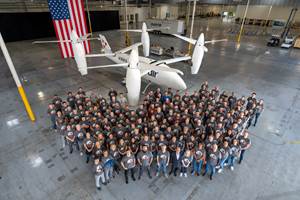How composites have become a necessity
Composites used to be one of many material options across industries and applications, but that's not the case anymore.

Joby Aviation’s all-electric vertical takeoff and landing (eVTOL) aircraft utilizes composites extensively throughout its build. The necessity of lightweighting the aircraft makes composites its only option. Read more about it in CW’s plant tour of Joby. Photo Credit: Joby Aviation
Compared to legacy materials like wood, iron, steel, aluminum and concrete, composite materials — and the composites industry — are relatively young. You can trace the current era of composites manufacturing back to the late 1950s, although it wasn’t until the 1990s and early 2000s that the industry really began to mature and grow.
Composites, being new and quasi-isotropic and even “weird” to some engineers, grew early on if evangelists could convince their customers to give composites a chance — mainly by displacing a legacy material in an existing application, particularly if that application might benefit from the lightweight/high-strength properties composites offer.
A good example of this are golf club shafts, which for decades were made almost exclusively with steel or aluminum. In 1969, Frank Thomas developed the first carbon fiber golf club shaft, which evolved to become a standard material option for golfers throughout the world. It also triggered application of carbon fiber in other sporting goods products dominated by legacy materials. Think tennis rackets, hockey sticks, fishing rods and bicycles.
Even in aerospace, which has famously embraced use of composite materials, growth has been incremental and dependent on legacy material displacement. This led to the infamous phrase “black aluminum” — used to describe the practice of replacing an aluminum part with a carbon fiber composite part (black in color).
Anyhow, in the early days of composites manufacturing, as any industry veteran will tell you, the industry and its proponents often were begging for applications, not choosing. So, design inefficiencies, incremental growth and fits and starts were par for the course and accepted as the part of the growing-up process. In this way, composites became a material option in a variety of applications.
Then, in the early 2000s, Boeing and Airbus took the Great Leap. Each decided to launch a new wide-body aircraft program — 787 and A350 respectively— that would use carbon fiber composites at an unprecedented scale, in primary structures for the wings, torsion box, fuselage, tail and more. This was aluminum replacement on a scale unlike any we’d seen and seemed to herald a paradigm shift in commercial aircraft materials use.
Around this same time, the wind energy industry began its modern era, with wind turbine blade length growing rapidly to meet the needs of rapidly increasing turbine power capacities. Composites quickly displaced legacy materials in blades that became increasingly strength- and weight-driven.
However, in other markets, such as automotive, composites usage was still dependent on incremental displacement of steel and aluminum. With the exception of wind turbine blades, composites survived only by being one of several material options in a variety of markets and applications.
That’s all changing, however. Over the last five years, we have seen the growth — and birth, in one case — of applications where composites are more than just an option. They are the one and only option. Not only that, but I would argue that these are applications that cannot exist without composites.
Example 1: Advanced air mobility (AAM) aircraft coming for the air taxi market. This is the birth. The OEMS serving this market are designing and producing all-electric aircraft that demand a 100% commitment to vehicle lightweighting to maximize range. Composites are the only material option here for primary structures and rotor blades.
Example 2: Hydrogen storage. The hydrogen economy is moving quickly to high-growth mode, putting pressure on the entire supply chain, particularly demand for carbon fiber pressure vessels for hydrogen transport and on-vehicle storage. Again, composites are the only material option here.
Example 3: Wind blades. Use of composites is not new here, but it’s important to note that wind blades are the largest consumer (by far) of carbon fiber in the world. As blades get longer, demand for carbon fiber in spar caps will only increase. Once again, composites are the only option here.
Example 4: Aerospace/space. The 787 and the A350 have made composites the de facto material of choice in aerostructures manufacturing. The question for any new aircraft program will be where and how to use composites, not whether or not to use composites.
In short: Composites have evolved from optional to necessary. We need to start thinking that way.
Related Content
Joby flies two eVTOL aircraft simultaneously in testing milestone
The latest in the company’s flight testing program targets certification testing acceleration and support of its passenger-carrying goals by 2026.
Read MoreOn the radar: Innovations in composite battery enclosures
A look at recently reported design, material and process innovations for composites-intensive battery enclosures, developed to support the ramp-up of EV and AAM vehicles.
Read MoreOverair completes assembly of full-scale Butterfly eVTOL vehicle prototype
Overair heads to flight testing in early 2024, marked by rapid prototype development.
Read MoreBeta begins Alia CTOL production aircraft flight testing
Flight of first production aircraft fresh off Beta’s full-scale manufacturing line in Vermont is followed by Special Airworthiness certification from the FAA.
Read MoreRead Next
“Structured air” TPS safeguards composite structures
Powered by an 85% air/15% pure polyimide aerogel, Blueshift’s novel material system protects structures during transient thermal events from -200°C to beyond 2400°C for rockets, battery boxes and more.
Read MoreVIDEO: High-volume processing for fiberglass components
Cannon Ergos, a company specializing in high-ton presses and equipment for composites fabrication and plastics processing, displayed automotive and industrial components at CAMX 2024.
Read MoreAssembling the Multifunctional Fuselage Demonstrator: The final welds
Building the all-thermoplastic composite fuselage demonstrator comes to an end with continuous ultrasonic welding of the RH longitudinal fuselage joint and resistance welding for coupling of the fuselage frames across the upper and lower halves.
Read More












